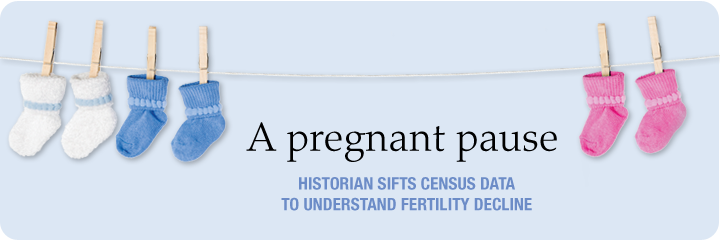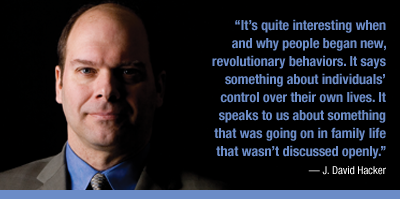
“Rock-a-bye baby, in the tree top, when the wind blows,
the cradle will rock,
when
the bough breaks, the cradle
will fall, and down will come baby, cradle and all.”
— An American nursery rhyme and lullaby
Something extraordinary began happening in the United States in the mid- to late 1800s. Cradles began to go empty, and an unaccustomed hush fell over nurseries.
In almost every hamlet, town and city in the country, family size began to deflate dramatically and a profound social revolution began to swell up. This long-lived phenomenon, which curiously enough began more than a century before the advent of the birth control pill, saw the average number of live births per woman drop from seven or eight in 1800 to slightly more than two today.

This decline changed the fabric of society throughout the 19th and 20th centuries and remains key to important social, economic, political and policy issues facing the United States in the 21st century.
Using uniquely prepared and processed census data and his own specialized talents, skills and training, J. David Hacker, a demographic historian, is revisiting and studying the early origins of this societal sea change. As he attempts to tease out and better understand the broad-based repercussions of this trend, he is also turning back and rewriting some important pages of history by helping to clarify the forces and factors that fueled it.
Steven Ruggles, director of the Minnesota Population Center at the University of Minnesota, says Hacker’s work is causing historians “to rethink early American historical demography from the ground up.”
But Hacker’s research and scholarship has secured him more than praise and recognition from his peers. He was also tapped last year for a fiveyear $674,000 grant from the National Institute of Child Health and Human Development. A prestigious award for a researcher in any field, the NICHD grant is all the more noteworthy for a historian. Hacker’s NICHD proposal was immediately well received and it was clear soon after his submission that he would receive the award.
“In some ways I was the ideal candidate,” Hacker said. “They were looking for people interested in population topics including fertility decline, who perhaps came out of other disciplines, without formal training. I’m mostly self-trained and have a strong background in statistics and quantitative methods.”
Fertility decline is of interest from a historian’s standpoint for what it says about historical actors, Hacker said.
“It’s quite interesting when and why people began new, revolutionary behaviors,” he said. “It says something about the changing status of women vis-à-vis men, industrialization, urbanization and the increasing cost of raising a child. It says something about individuals’ control over their own lives. It speaks to us about something that was going on in family life that wasn’t discussed openly.”
Perhaps even more important, however, are the almost endless repercussions declining fertility rates produce across every realm of human activity and governance. From raising armies and growing the economy to housing, health and social service concerns, almost every policy consideration one can think of is significantly affected by population size and aging trends — both of which are directly linked to fertility rates.
Hacker’s NICHD-funded project has two objectives that could have a major impact on policy debates influenced by the ebb in fertility rates. First, Hacker intends to describe American fertility decline in greater detail than ever before possible. Second, he intends to explain that decline, and to shed light on the economic, social, cultural and geographic factors correlated with it. In addition to its value to historians, Hacker’s work could provide important clues about how to reverse the trend, and that might someday become not only advisable but necessary.
Today in the United States, the total fertility rate hovers at about 2.1, very near to “replacement rate,” the rate at which every death is offset by the birth of a child who will survive to adulthood. Beyond this point, populations begin to decline and age rapidly. Couple that with a decline in mortality and the effects on the population can be staggering.
In the 19th century, for instance, half the population in the country was 15 years of age or under. Today the median age is 32. By 2050, with the national fertility rate holding at its current level of 2.1 births per woman, half of the population will be 39 or older. In the 1880s, life expectancy was only about 40 years. By 1920, life expectancy had increased significantly, and, today, it hovers near 80 years.
This major demographic transition, which has been mirrored around the globe, is therefore key to important social, economic, political and policy issues facing the country and the world. It represents a serious challenge to the social welfare state, which by its nature relies on a preponderance of young workers to support retirement and health-care programs for the poor, the sick and the elderly.
While non-historians are likely surprised to learn that the timing of fertility decline precedes by more than 100 years the advent of the birth control pill, historians have long held that it began at the turn of the 19th century. Hacker’s research shows, however, that the decline actually began much later, starting in 1840 and becoming more pronounced after the Civil War. Debunking theories of American demographic exceptionalism, his work brings the timing of the U.S. fertility decline in line with that of most other industrializing countries. “We’ve long known there has been a long-term decline in fertility in the United States,” Hacker said. “There’s been a great deal of research on it. It’s interesting to economic historians, social historians, women’s historians, historians of medicine. Everyone’s taken a shot at this research.”
page 1 | page 2